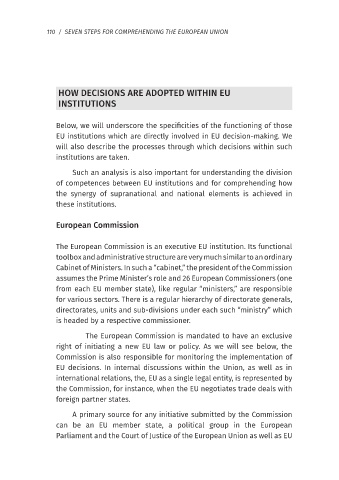Page 111 - SEVEN STEPS for COMPREHENDING the EUROPEAN UNION
P. 111
110 / SEVEN STEPS FOR COMPREHENDING THE EUROPEAN UNION
HOW DECISIONS ARE ADOPTED WITHIN EU
INSTITUTIONS
Below, we will underscore the specificities of the functioning of those
EU institutions which are directly involved in EU decision-making. We
will also describe the processes through which decisions within such
institutions are taken.
Such an analysis is also important for understanding the division
of competences between EU institutions and for comprehending how
the synergy of supranational and national elements is achieved in
these institutions.
European Commission
The European Commission is an executive EU institution. Its functional
toolbox and administrative structure are very much similar to an ordinary
Cabinet of Ministers. In such a “cabinet,” the president of the Commission
assumes the Prime Minister’s role and 26 European Commissioners (one
from each EU member state), like regular “ministers,” are responsible
for various sectors. There is a regular hierarchy of directorate generals,
directorates, units and sub-divisions under each such “ministry” which
is headed by a respective commissioner.
The European Commission is mandated to have an exclusive
right of initiating a new EU law or policy. As we will see below, the
Commission is also responsible for monitoring the implementation of
EU decisions. In internal discussions within the Union, as well as in
international relations, the, EU as a single legal entity, is represented by
the Commission, for instance, when the EU negotiates trade deals with
foreign partner states.
A primary source for any initiative submitted by the Commission
can be an EU member state, a political group in the European
Parliament and the Court of Justice of the European Union as well as EU

